Tonic for dark brown hair. Leaves stains on the bathroom, gets dirty, color washes off quickly
Ok, this post is almost no different from (+/- some photos), so anyone not interested in hair coloring can skip it)
I needed to streamline my experience in hair coloring for the year (just at the beginning of February a year ago I was bleached for the first time) in order to calm down (yes, I very rarely have obsessive cleaning irl, but here it is on the computer and in notes).
A great ode to love for "Tonic" from Rocolor under the cut.
Shades I used:
Black (1.0)
Wild Plum (3.1)
Eggplant (3.2)
Iris (4.25)
Bordeaux (4.6)
Indian Summer (6.65)
Mahogany (5.34)
Red Amber (5.35)
Ripe Cherry (3.56)
I had two stages with Tonic.
First- applied color Black (1.0) on unbleached hair that has been dyed many times with permanent red and red dyes. The color at that time was chestnut-reddish after using the L'Oréal Preference (Feria) shade of Mango. I couldn’t decide whether I wanted to dye my hair back black, so I took a tint product. Then I didn’t know that I had every chance of not wash off the black Tonic from your hair or get an unsightly dirty color when washed off. But black suited me, and after a few days I painted it all over with persistent Preference color Brazil (it’s almost black). Experience of using Black on such hair:
They were etched with ammonia paints, so Tonic lay on them. An even black thick color, without blue or green, but also without shine.
Tonic DOES NOT TAKE AT ALL my natural regrown gray-blond hair.
Whether and how intensely the Tonic applies to the hair depends not only on the natural tone of the hair or the degree of lightening, but also on its structure: thickness, hardness, porosity.
When washed off (I managed to wash my hair 2-3 times before painting with permanent paint), the color did not wash out into, again, greenish, bluish or brown, but the reddish base began to show through in strands here and there.
The hair became coarse due to the fact that it was not in the best condition from regular coloring. durable paints(once every 3-4 weeks) and using a styling gel, which also dried them out
Stage two- use of "Tonic" on bleached hair.
This long story, as it later brought out the black color, and it relates to other hair products.
After exposure to the hair and subsequent lightening (the base came out uneven due to the use of persistent almost black dye for 3 years: from white at the roots to light peach), I was painted with Igora Royal paint on 6% oxide, tone 7-77 ( ginger).
The color is very pretty, but the “long-lasting” ammonia dye has never been long-lasting on my hair, both before and after bleaching. After about 2 washes, the color stopped shining, and in 2 weeks (I wash my hair once every 2-3 days, but here after bleaching it sometimes lasted 3-4) it faded completely to fawn:


I spent a long time choosing what to use from tint products for a rich red color, since there is no point in treating well-bleached hair with ammonia dyes with a high percentage of oxide once every 3-4 weeks. I walked around in circles and the choice fell on Tonic Red Amber (5.35). I was very afraid that it would turn out too red, since I have a rich and sad experience of getting red instead of the declared red color, strand test:
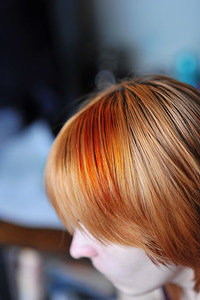
In contrast to this washed fawn color it seems very intense, but I was satisfied with the result, I applied "Tonic" in pure form for 10-15 minutes:

The color turned out to be not very uniform the first time due to the light base and short exposure time, but on the contrary it looked very beautiful: there were reddish strands and more golden ones, which created beautiful game colors. I really like the color of Amber right after application and before the second wash: more reddish copper than orange. After the first time, I kept Tonic for 30 minutes during the next color updates.

After the hair is washed 2-3 times, the color turns orange (the same happens if you keep the Tonic for a short time to maintain the color, 10-15 minutes).


After 2 weeks, the color lightens, fades and stops being so shiny, but, as you can see, it still stays well on the hair (here 2-3 weeks from last update colors):

Then I wanted a bright red color.
For this I mixed Red Amber With Indian Summer (6.65) in a ratio of 2:3 and applied for 30 minutes. There is no photo immediately after painting, here after 1 wash, the color will be bright red. However, it quickly faded into a redder color within 10 days:
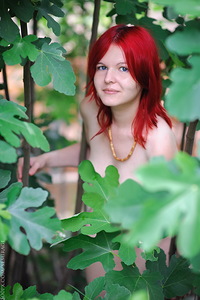



I wanted a colder and darker shade (under the dress), so I used Indian Summer in its pure form for 40 minutes. Here you can clearly see the difference in the washed-out mixture of Amber with Summer and pure Summer compared to the dress:


However, after 1-2 hair washes Indian Summer goes from cherry to shining red:


The first time it washed off for me, it still turned brick, and it also became lighter. Here the roots are lightened and the lightener is slightly stretched along half the length of the hair, this creates such a fiery gradient, the ends of the hair were not touched by the lightener, they themselves washed into this color:
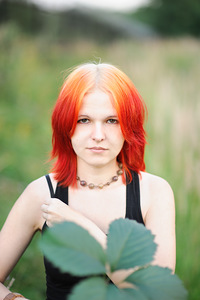
After lightening the roots, I dyed my hair again with Indian Summer, but it was new bottle+ mixed 50% with hair balm. Alas, either this bottle turned out to have a high content of pink pigment (the skin and the bathroom at that time were very pink and were difficult to wash off), or pink pigment had already accumulated in my hair, so something happened that I already knew about: the red color began to wash off in pinkish. Well, not to mention that the color faded a little, but even after 3-4 weeks it did not wash out significantly.
Then I decided to try to make the red a little darker by mixing Mahogany (5.54) And Ripe Cherry (3.56). I experimented with proportions for a long time, but Cherry keeps the mixture very dark (in its pure form, the color from Cherry is very dark, this is really the color ripe cherries), even if it is 0.3-0.25 of the total volume. As a result, I applied a mixture of Mahogany and Cherry in a ratio of 1:6 + 50% hair balm to my hair for 15 minutes. The result was not much different from pure Summer, only it was immediately red, not cherry, and pink was nailed down for a while, but for about 2 weeks. Only after painting

Here, 5 weeks after dyeing, the hair is pinkish, the color is still very dense:

After lightening the roots to white with yellow tint, I took a chance and dyed my hair with a mixture of Eggplant (3.2), Iris (4.25) and Wild Plum (3.1)+50% balm for 15 minutes. There was most of Eggplant, a little less of Iris, and no more than 1/5 of Plum.
I knew that I was unlikely to get a beautiful rich purple over red without additional lightening of the entire length to at least pink, but it was not possible to lighten all the hair.
Base (6 weeks from painting with Mahogany with Cherry + root lightening) and result:



The color was very uneven: nice cool purple roots (the color you'd get from a mixture like this on well-bleached hair), the rest of it an aubergine color with vertical stripes of a dark blackcurrant-type color, and a dark red at the back of the head where the mixture was applied last. In fact, despite the heterogeneity, the result was not bad; after 1-2 washes, the color became a little lighter and distinctly purple. But after 3-4 it became somehow pink-gray. Moreover, the roots, where the color was initially the purest and most beautiful, were washed away worst of all, into a cold gray:

Looking ahead, I’ll say that Wild Plum mixtures have this effect on my hair. It allows you to get a beautiful cool purple color when mixed with Iris or Bordeaux, but it is washed off in 3 washes, and the hair then acquires a grayish tint and loses its shine, unlike the use of other shades, when the hair shines for 2 weeks after dyeing.
To even it all out, I applied it to my hair. Eggplant With Not a large number Bordeaux (4.6) and shampoo to stir (the eggplant was sold to me expired and thick). The color turned out to be a brilliant lilac in cold daylight, and more reddish-burgundy in warm artificial light:

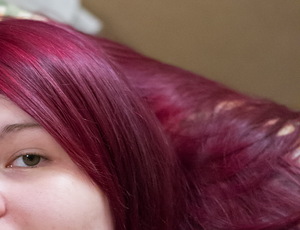
Tonic's eggplant does not produce a cool purple color in its pure form! (I knew about this in advance). Often it turns out dark purple and dull dirty for some people, but I was happy with the result: the shine returned to the hair, the color was rich, although quite dark. Wash off in a warmer environment a couple of weeks after painting:

And this is the result of partial lightening of the Eggplant, resulting in a peach color:

Partial lightening was needed for the next one.
On the top of the head Bordeaux with balm 1:3, 10-15 minutes.
Below is pure Eggplant (20 minutes), above is stretched with a mixture of Bordeaux and Eggplant for about 10 minutes. And at the very ends of the Eggplant with Plum for literally 3 minutes.


Alas, this beautiful gradient did not last long, it washed off ugly (yes, I tried Plum again with a lot of balm later). After washing out the color with shampoo and salt, the following base was obtained:
On top of it was applied Iris with balm 1:1 for 20-25 minutes:
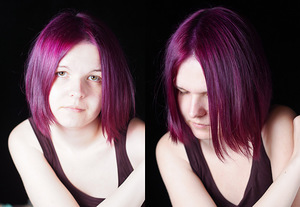
The despondency and despair on my face does not apply to the resulting shade, the deep dark purple from Iris is very nice. Alas, the lower part of the hair is already clogged with pigment from previous dyeing, so the color there is duller than on the top.
Lightening the roots and part of the length from the washed off Iris + haircut:
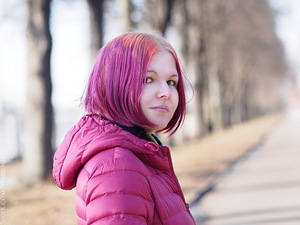
It turned out to be a beautiful cool pink, by the way, I was thinking of doing it for the entire length, but I didn’t know how best to mix Bordeaux or Bordeaux with Iris, they give a different color a little at once.
So I decided to pervert while I had at least a couple of inches of bleached hair. Some people manage to turn well-bleached ones into lilac or purple with Amethyst in 2 applications. Unfortunately, I only had enough for one thing, with the balm it took 40 minutes:

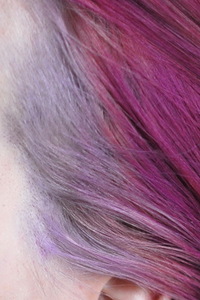
Part of the hair that was almost white with yellowness became dirty gray-lilac, and the yellow and peach just got stuck together. This is a logical result from Amethyst, it’s a pity that we weren’t able to complete the experiment(
Here is a mixture of Iris, Bordeaux and Plum (less plums, approximately equal amounts of Iris and Bordeaux) + a bunch of balsam, at least 80%. It’s beautiful, but it faded into purple after 3-4 washes (And it was uneven: the roots and ends were pinkish. The roots were due to lightening, but the ends were due to the fact that, on the contrary, they were clogged with pigment and now take on worse/are washed out faster.

It’s the same, but after 3 washes, it seems. You can see that the color is becoming warmer.

This is Bordeaux, Iris and Plum in approximately equal proportions + 50% balsam.
Yes, the color came out dark, but the previous version quickly washed out, and I decided to take a risk. Lasted longer and washed off more evenly.


When it was washed off well, it was painted over with Bordeaux with a drop of Iris and a bunch of balm:


Full sheet for 2014:

1. Iris with balm 1:1, photo immediately after painting
2. Some kind of mixture of Plum, Iris, Bordeaux and balsam, 2-3 washes from painting
3. Again Plum, Iris, Bordeaux (more Plum, less balm)
4. On thoroughly washed 3 - Bordeaux with a drop of Iris and a bunch of balsam
5. On the 3rd round Plum, Iris, Bordeaux after several washes - uneven
6. Plum, Iris, Bordeaux invariably after 7-10 days began to wash out into this purple canoe, as if from pure Iris. Plus it burned out, apparently. You can see that inside the strands are of a cooler shade.
7. NEXT update Plum, Iris, Bordeaux - plums are over-swollen, ink detected.
8. Attempts to wash off the dirty purple garbage as much as possible were no longer effective. Here is Bordeaux with a lot of balsam, but it’s clear that it’s not as bright and rich as 4, it’s more like 1 and 5
9. A very strange experiment: for tarnished 7 - Amethyst with balm 1:1 twice for 1.5-2 hours. The color came out cooler in daylight, but since Amethyst's pigments are very sensitive to the spectrum of the light source, in warm light (sunset/dawn, lamps with a warm color temperature) it looked dark and dirty, like Eggplant at its worst.
10-12. Anthocyanin V05: different lighting and colors:
- 10) First paint job faded 8. The color was warmer and less dense than subsequent paint jobs
- 11) Second painting, the light of the sun at sunset. Behaves similarly to Amethyst: looks dark dirty purple in warm lighting, reacts to it much more strongly than the purple obtained by mixing Plum with Bordeaux and Iris
- 12) About 3 weeks after 11, diffused daylight, immediately after painting it looked like
From all this sheet it is clear that no matter how much you mix Plum, Iris and Bordeaux, EVERY time you come out DIFFERENT. It washes off differently and fades.
I've been dyeing my hair with anthocyanin since July, but haven't bleached it since May. A third of the length is already dark, there are no demonstrative photos in color, but IR shows the growth well. Yes, my hair grows slowly, in about 8 months.
General notes regarding the use of Tonic tinted balm:
This product is great for coloring pre-lightened hair to extremely bright shades.
- At the same time, the cost of the Tonic tint balm is much lower than that of well-known tint products foreign manufacturers, and durability is higher.
- Unlike using permanent ammonia dyes on bleached hair, it gives a much more lasting color (up to 2 to 6 weeks of a beautiful radiant shade) without harm to the hair.
- Hair is shiny and smooth.
- If your hair is naturally dry, or has become so from the use of lightening agents, styling products, hair dryers/iron, etc., then “Tonic” when used in its pure form can lead to additional dryness. To avoid this, it is recommended to mix Tonic with any hair balm before application.
- You can also mix “Tonic” with a large amount of hair balm to reduce the intensity of the shade.
- Also, when using “Tonic” with balm, the coloring pigment is less absorbed into the hair: the color is washed off faster, and if necessary, it is easier to lighten the hair.
- All shades of “Tonic” can be mixed with each other, but not all give an interesting result or give it at all (using a ruler to tint lightened and gray hair on poorly bleached, dark hair, hair dyed in a darker/richer shade).
- Apply “Tonic” to freshly washed, damp hair. It is not recommended to use hair balm before coloring.
- Exposure time affects not only the intensity of coloring, but also uniformity.
- It is not recommended to use “Tonic” in dark shades (Black, Mocha, Chocolate, etc.) on bleached or natural light hair, as they can give unsightly shades that wash out very poorly and do so unevenly. These shades are designed to tone natural dark hair.
If you want to dye natural, previously undyed or bleached hair:
Everything is very individual, “Tonic” can either take your hair or not, depending on the structure.
- Durability also depends on this factor: the balm may be completely washed off after 1-4 washes, or it may not be completely washed off at all.
- Therefore, be careful and prepared for this when using “Tonic” on natural blond hair. As a rule, it is possible to obtain fairly bright and saturated shades with them.
- For dark hair, it is recommended to use shades of Bordeaux, Iris, Eggplant, Red Amber, Golden Walnut, Golden Chestnut to achieve red or ginger shades, but they will not be bright.
- It is not recommended to use on natural, both light and dark hair shade "Wild Plum". This is a balm blue, however, its basis is green pigment. This is one of the most durable pigments and shades of Tonic. By dyeing your hair with Plum, you run the risk of getting an unsightly swamp-green tint on your hair during the process of washing off the color, which will not go away even after bleaching. It can be neutralized with red or red tint products, but you won’t get your hair color back!
- Indian Summer shade should be used with caution on both natural and bleached hair. Especially if you want a red color rather than a pinkish color. The basis of this shade is just a pink-raspberry, very durable pigment.
- “Tonic” heavily stains the scalp and body and is difficult to wash off plumbing fixtures. Therefore, before dyeing, apply greasy cream to areas of the skin that may become stained (ears, forehead, neck) and be sure to use gloves not only during dyeing, but also when you wash off the balm from your hair.
- Hair dyed with "Tonic" (and not only immediately after dyeing, but also for a long time) can dye even lacquered jewelry made of polymer clay(beads and earrings).
Overall: an excellent product for coloring and tinting pre-bleached hair, allowing you to achieve rich and long-lasting shades. Ineffective on unbleached hair. It is better to entrust hair lightening to a good hairdresser (alas, even a trip to an expensive salon does not guarantee that your hair will not be burned using a high concentration oxygen agent for a faster reaction) and/or study the information regarding hair lightening very carefully, and use only professional lightening products.
However, if you very often (once every 1-2 months) want to radically change your hair color (from blue to red or from green to blond), then Tonic may not be the best choice. optimal solution due to the durability of the pigment even after subsequent lightening. In this case, it is better to use less durable tint products from foreign manufacturers (Manic Panic, Directions, Crazy Color, etc.).
P.S. I don’t help with answers to the questions HOW TO MAKE LILAC HAIR I DON’T WANT TO LIGHTEN!!11 What happens if you mix Eggplant and Amber? Will this color suit me? etc.
I advise you to CAREFULLY READ THE INFORMATION IN THE MENU
Women love to change themselves by transforming themselves. How to do this with minimal losses? Change the color of your curls! And if at the same time you want to treat your curls as carefully as possible? There is an alternative to aggressive dyes - use Tonic tinted balm on bleached hair. We will also look at how to remove tonic from bleached hair.
Why do girls prefer toning rather than coloring? The answer is simple - this method has significant advantages:
- Gentle effect. Does not destroy natural pigment. Penetrates exclusively under the scales, and not deep into the structure.
- Gentle care. Natural ingredients moisturize, add shine, even out, make skin silky and manageable.
- The effect is not permanent. Lasts up to 2 weeks, is washed off gradually, without causing harm to appearance. Possibility of frequent image changes, quick correction in case of a negative result.
Contraindications
- There are damages and irritations on the scalp;
- Exposure to chemical agents was carried out several days before use;
- There is individual intolerance to the components;
- The curls are in terrible condition after aggressive treatments.
Compound
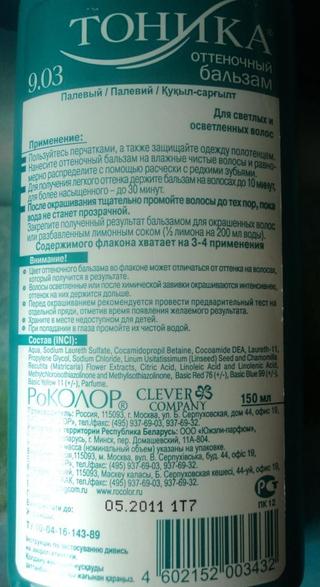 The substances included in the composition, as stated by the manufacturer, can not only color, but also have a caring effect. Let's look at this in more detail:
The substances included in the composition, as stated by the manufacturer, can not only color, but also have a caring effect. Let's look at this in more detail:
- Sodium lauryl sulfate is the active ingredient instead of the usual ammonia. Although it is not useful, it has a much less destructive effect.
- An antiseptic and antistatic agent allows you to disinfect and remove excess static, and forms a protective barrier.
- Beeswax prevents the formation of splits, smoothes and nourishes the bulbs.
- Flax seed extract helps moisturize and nourish.
- Vitamin F has protective properties and moisturizes.
- Citric acid softens and adds shine.
- Emulsifiers, preservatives, and flavorings are necessary to bring the product to the consumer in the form in which it is supposed to be: uniform consistency, with a pleasant aroma, safe and sound according to the expiration date.
- Finally, dyes are needed to achieve the most important thing - color change.
- It really contains a lot of useful, caring additives. Thanks to this, a positive effect on curls is achieved.
Directions for use
Before use, be sure to carefully read the instructions.
Important! Be sure to do an allergy test if you are using the product for the first time. Apply a small amount of the substance to a small strand of hair from the depths. This way you can understand the general reaction of the body, and the future shade will also be clear.
The darker the hair, the less noticeable the result. On colored hair, the uniformity of the effect will not be uniform. A completely unexpected effect is possible, not what is expected based on the stated characteristics.
For work you will need:
- Tonic balm;
- water;
- comb with sparse teeth;
- container made of glass or plastic;
- gloves (polyethylene disposable);
- brush;
- shampoo;
- towel.
Useful video on how to use colored tonic:
Important! When applying, try to distribute it as carefully as possible, do not apply it to the skin because “stains” will remain, and if you try to wash them off, the new color will suffer.
Sequence of actions:
- Comb your hair thoroughly and wear gloves.
- In a prepared container, mix Tonic with water according to the proportions from the instructions.
- Lightly moisten the strands, apply the composition with a brush from the parting to the center, then down.
- When all the hair is covered, comb it with a comb and lightly beat it with your hands until it foams slightly.
- Cover with a towel.
- Wash off with shampoo.
Instead of the above, it is possible to add a certain amount of the product directly to the shampoo. Wash your hair as usual. The color intensity will be weaker and less durable.
How to quickly wash off Tonic from bleached hair
Sometimes the result does not live up to expectations. Most often this happens if the hair has previously been chemically treated (dying, perming).
Useful video on how to wash off toner:
You can use a special wash, but this chemical substance. Natural products are suitable for this purpose: burdock oil, castor oil, lemon juice, very fatty kefir. Distribute over the strands, wrap tightly, and leave for an hour. The “natural” washing session is repeated after 2 days. Unsuccessful coloring begins to disappear after a few regular washes.
Effect of different shades of balm
When using Tonic on light, bleached hair, the color acquires a really bright shade, much more intense than the manufacturer indicates. Especially if a rich version was used such as “Indian Summer”, “Red Amber”. In any case, on colored hair the effect of the balm will be much more noticeable.
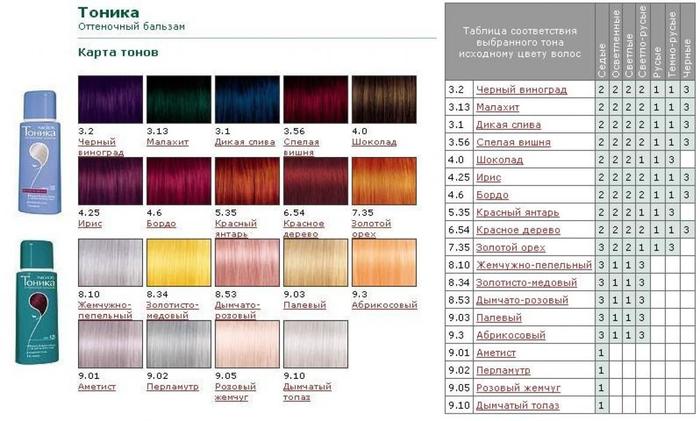
If using light shades: " Pink pearl», « Amethyst“The hair must certainly be light, preferably bleached. Otherwise, the effect of the tonic may not be seen.
Shade options " Pearly ash», « Platinum blonde», « Pale yellow» are able to remove yellowness from bleached hair. True, the color will become smoky. In this case, there is no need to carry out the dyeing procedure, just mix Tonic with a regular balm, hold for 5-10 minutes and a beautiful color without yellowness is ready.
Important! The shade “Chocolate” on bleached hair will not look the same as indicated in the picture; for example, it may turn out to be too bright with a reddish tint.
Using a balm can provide invaluable assistance in hair care. After all, he takes care of hair damaged by aggressive agents.
Photo after staining with Tonic

7.43 Golden chestnut + a little 7.35 Golden walnut, a lot of balm on the faded red

6.45 Red on bleached hair over 7.43 Golden brown

1. 5.35 Red amber + 4.6 Bordeaux with a predominance of KY + balsam (about half the volume of the entire mixture)
2. 4.6 Bordeaux + 7.43 Golden chestnut + balsam. There was about half of the balm relative to Tonic. The mixture had a red and pink color.
All girls dream of looking beautiful, well-groomed and attractive. Big role in appearance hair plays. It is important that they look healthy, shiny, and the color is bright and rich, causing the delight of others. Tinted balm "Tonica. Bordeaux" perfectly refreshes the color and gives a natural shine. This tool is used to easily update your style. The color does not change radically, but takes on an attractive, radiant hue.
How to choose the right one
When choosing a tint balm, you first need to determine your color type. The hair shade must be selected especially carefully; it must be in harmony with the eyes and skin. Stylists advise choosing a tone as close as possible to your native color. The tonic color palette allows you to easily choose the one you need:
"Tonic. Bordeaux" fits perfectly on dark hair. This tone looks best if the natural color is dark brown. In addition, mocha, toffee, chocolate, and wild plum are suitable for dark shades.

For natural light shades, experts recommend using chocolate, light brown, red amber, and mocha.
Benefits of the balm
"Tonic. Bordeaux" makes hair color deeper and more saturated. It contains not only high-quality dyes, but also a whole vitamin complex that helps take care of your hair. It becomes shiny, silky and attractive.
![]()
Features of tonic:
- there is no ammonia in the composition, and therefore the hair structure remains intact;
- the product is washed off within 1-2 weeks, which means there is room for experimentation;
- it is permissible to use the product to eliminate the difference between dyed hair and regrown roots;
- the palette makes it easy to choose the desired shade;
- affordable price.
How to use the product correctly
The consistency of the balm is liquid, so be sure to follow the listed precautions to avoid leaving stains on your skin and clothes.
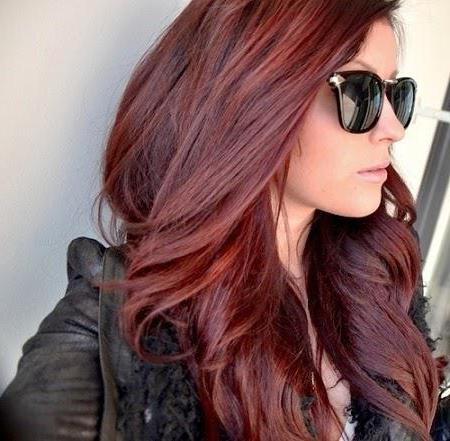
We present step by step instructions to use the product:
- Protect your clothing with a towel.
- Apply a rich protection cream along the hairline, as well as on the ears and neck. skin from coloring.
- Be sure to wear gloves on your hands to protect your nails and skin from staining.
- Apply conditioner to damp, clean hair. First, paint the roots at the back of your head, and then distribute the toner evenly. To simply refresh the color, just leave the product on for five minutes. Light shade will appear in 10 minutes. But for a rich tone to appear, you need to wait about 30 minutes.
- Rinse it off warm water until it becomes transparent.
- To consolidate the result, you can use the juice of half a lemon with a glass of water. Or you can just use a balm for colored hair.
Remember that "Tonic. Bordeaux" is strictly prohibited for use after perm and lightening. Components of the products may react and lead to undesirable results. It could be a shade mismatch. In the worst case scenario, significant damage will be caused to the hair structure.
Choose your shade slowly. Did you like the two shades? Try taking two small strands and dyeing them. Then compare the results and make an informed choice based on that. Still can't decide? The toner washes off quickly, so we recommend doing test stains. Visualization will certainly help with resolving the issue, and Tonic. Bordeaux will not do any harm to the hair. You can see the photo below.

How to wash off toner
"Tonic. Bordeaux" on the hair looks bright and attractive, but women are characterized by a love of change. Therefore, despite washing off the toner naturally within 1-2 weeks, girls begin to look for a way to quickly remove one tone in order to replace it with another. Next we will talk about the most popular and safest options.
Burdock oil has many beneficial properties, including is in a great way for washing off coloring pigment. To do this, you need to make a mask: mix burdock oil and lemon in a 1:1 ratio. Apply the mixture to your hair and then wrap it up. You should wear the mask for no more than an hour, then rinse it off thoroughly. You can use this remedy once every two days.
Kefir forms an acidic environment, which helps remove color pigment from the hair. Just take a fermented milk product (fat content is not important) and apply to your hair. Leave for an hour, and then rinse thoroughly with water and lemon juice (it will remove the unpleasant odor).
One of the most simple ways- wash your hair several times a day. But to prevent this from causing harm, be sure to use a mask.
Two more effective and useful masks that will help wash out the pigment:
- the mask is made with a base of clay or honey;
I have been using Tonic tinted balm for a very long time... I don’t even remember in what year I picked it up for the first time... I remember that I was small, stupid, I really wanted a bright shade, and I didn’t want to burn my hair with dyes at all wanted. In general, something urgently needed to be decided! That's when the idea of a coloring shampoo came to mind. Whatever shades I bought - sometimes it seemed to me that I had tried the entire palette of Tonic colors, except for the boring natural ones. But I would like to tell you about my favorite and most frequently used ones.
For example...
BLACK.
Black color has saved me many times. Black suits me best and I feel comfortable in it. Although, if you drop black Tonic onto a white surface when painting, it turns out that this resin liquid is never black, but... dark blue.
I only dyed my brown hair with black tonic and noticed this funny thing - the gothic black “Tonic” turns green when washed off. So lush green, like spruce. In the sun this shade is very visible. But the plus is that it washes off gradually. The “minus” is the same as with every “Tonic” - a noticeable gray tint to the pillowcase... While coloring and washing your hair, it is better to immediately paint your nails with some black or dark varnish. Seriously.
Photo proof of what a hot brunette I was:

RED AMBER. Also, the coloring was specifically for light brown hair... and, lo and behold, the boring mousey light brown color suddenly acquired a beautiful warm golden hue when washed off. Moreover, it’s a beautiful shade, warm, deep and rich... But this redness ate into the structure of the hair and was not washed out. On the one hand, this is good - because the hair has acquired a nice shade, which remains even after the 8th wash, but on the other hand, it is bad - especially if after going red you wanted to dye your hair... some other color. This time the pillow is already taking on an orangish tint. Nails too.
Photo of me as a shameless redhead:
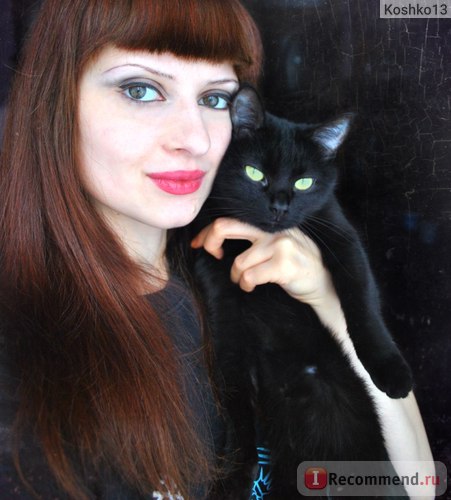

BORDEAUX. At one time this color was my favorite and was considered by me the most beautiful. The shade turns out beautiful, juicy, like rose petals. It washes out to a lovely pinkish tint - just a candy, not a tint. Even on unbleached hair it looked juicy. We paint our nails red or cherry, we take pillowcases of the same color... The bathroom may look like you dismembered someone there, but these are minor things, don’t pay attention. The main thing is the color on the hair!

INDIAN SUMMER. I have already tried this shade on bleached hair. The color turned out different from Bordeaux. More red, or something... Bordeaux is more pink... Since it was dyed on bleached hair, it was very bright and lasted a very long time, namely three months... after three months I couldn’t stand it and dyed it a different color, but the fact remains that those who Those who have used “Tonic” know this without my saying anything: “Tonic” lasts for a very long time on colored hair. On poorly bleached (chicken-yellow) hair, “Summer” gives an orange tint when washed off, which is to be expected. But on more or less lightened ones everything is beautiful. We paint our nails red or black. Ideally, burgundy.
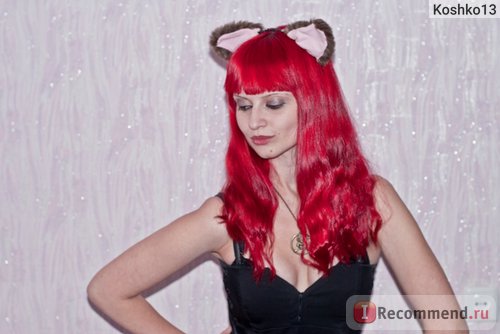



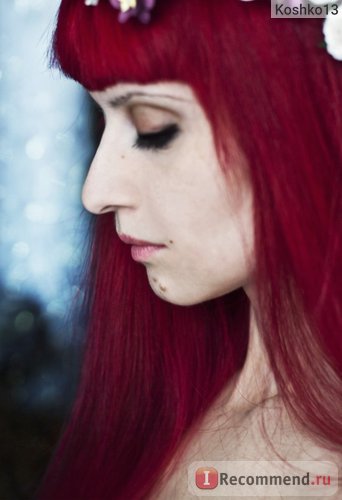
But “Summer” was washed off in this color) Like chewing gum - the children were delighted!
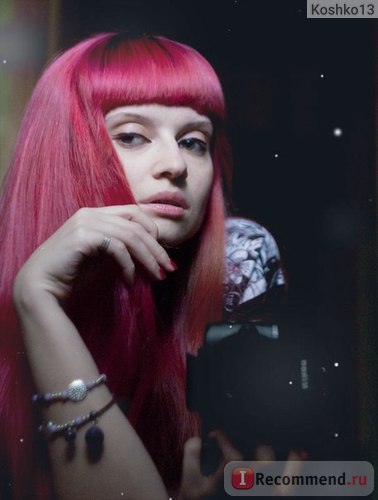

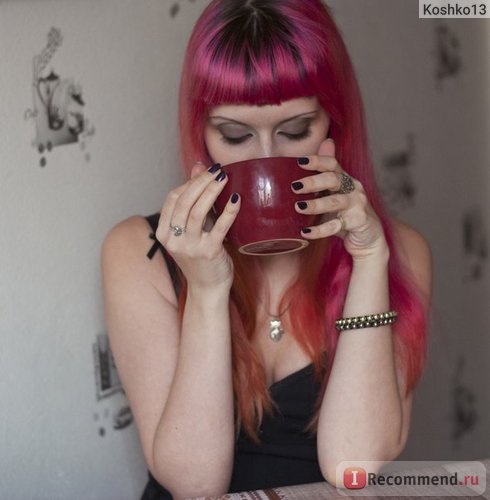
WILD PLUM. I did not use “plum” in its pure form. “Indian Summer” never completely washed off on my bleached hair (it lasted more than 3 months; on unbleached hair it would wash off much faster) - so I had to dye it with what I had. As a result, “Plum” turned out to be very thermonuclear - it did not recognize any halftones or anything. When test applied to a pinkish strand and left for 15-20 minutes, it gave a truly heavenly blue color. There was not even a hint that there was a pink tint. But on chicken-yellow hair, “Plum” gave an honest green– you shouldn’t even be surprised here, because everyone who didn’t skip art classes at school knows that blue + yellow = green. So it was, everything is fair. And yes - we paint our nails black or dark purple again!

This is the color it looked like in the sun:
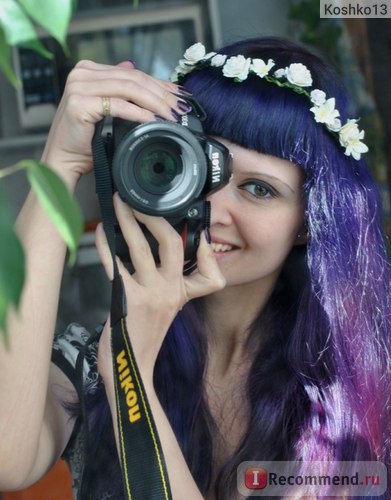


My "blue")))
To prevent strange effects, it was decided to take 4 parts “Bordeaux” and 1 part “Wild Plum” - to get a mulberry or grape color... Whatever! Even while stirring, it became clear that you can say goodbye to violet - “Plum” eats “Bordeaux”. The end result is a grape color that I am very pleased with. We'll see how it behaves when washed off. If there is something interesting, I’ll add new photos to the review.

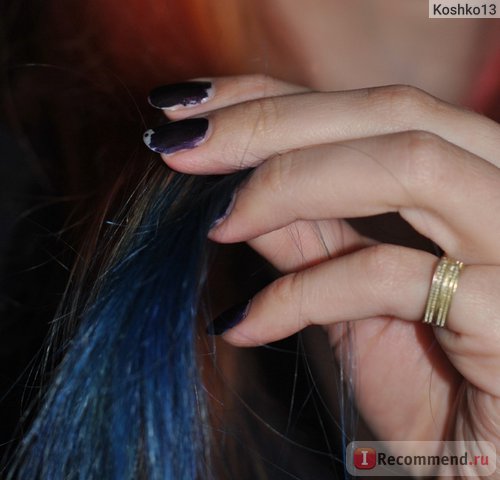
By the way, in correspondence with girls, phrases flashed several times that “Tonika” dries out the hair... I’ll be honest, I definitely never noticed anything - my hair was always soft, shiny and silky. And in addition, they smelled nice and were easy to comb.
In addition, from my photos you can quite see my hair after Tonic - it’s not over-dried, it lies beautifully, and shines.
Update from 06/02/2014:
I found a couple of crazy photos. Don’t be alarmed - these photos show water after I rinsed my freshly black-dyed hair in it)) The water, by the way, is gothic blue, I then spent an amazing 10 minutes cleaning the bathroom from this sea of gothic (with a regular cleaning product powder, without any frills)
The quality of the photos is terrible - my friend and I only had our phone at hand, but you can get an idea of the color and degree of the nightmare
![]()

Update from 06/17/2014:
I found a photo where I dyed my hair “something like that” before the New Year. In the photo I have Black and Bordeaux on unbleached hair
And again, I’ll add - everything is soft and shiny, no over-drying, which many have written about

Update from 07/29/2014:
I decided to refresh my hair. For the color that was purple, but began to fade into some kind of lilac, I decided... to make small blue strands. To do this, I took “Wild Plum” and applied it to 10 minutes
Violet on lightened
This is a June photo. That is, purple from April to June became like this:
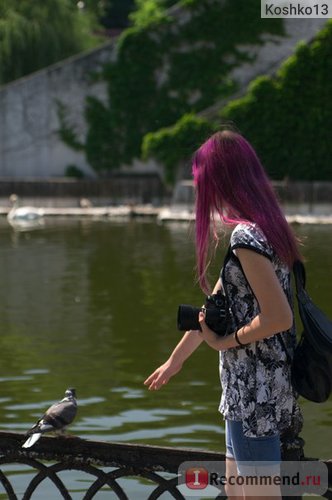
If anyone has questions - ask
To me - on a first name basis
Be beautiful!








 About the company Foreign language courses at Moscow State University
About the company Foreign language courses at Moscow State University Which city and why became the main one in Ancient Mesopotamia?
Which city and why became the main one in Ancient Mesopotamia? Why Bukhsoft Online is better than a regular accounting program!
Why Bukhsoft Online is better than a regular accounting program! Which year is a leap year and how to calculate it
Which year is a leap year and how to calculate it